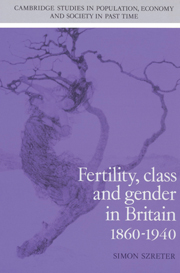Book contents
- Frontmatter
- Contents
- List of figures
- List of tables
- Acknowledgements
- List of abbreviations
- Introduction
- Part I Historiographical introduction: a genealogy of approaches
- Part II The professional model of social classes: an intellectual history
- Prologue: the fertility census of 1911 and the professional model of social classes
- 2 Social classification of occupations and the GRO in the nineteenth century
- 3 Social classification and nineteenth-century naturalistic social science
- 4 The emergence of a social explanation of class inequalities among environmentalists, 1901–1904
- 5 The emergence of the professional model as the official system of social classification, 1905–1928
- Part III A new analysis of the 1911 census occupational fertility data
- Part IV Conceptions and refutations
- Appendices
- Bibliography
- Index
- Cambridge Studies in Population, Economy and Society in the Past Time
Prologue: the fertility census of 1911 and the professional model of social classes
Published online by Cambridge University Press: 16 February 2010
- Frontmatter
- Contents
- List of figures
- List of tables
- Acknowledgements
- List of abbreviations
- Introduction
- Part I Historiographical introduction: a genealogy of approaches
- Part II The professional model of social classes: an intellectual history
- Prologue: the fertility census of 1911 and the professional model of social classes
- 2 Social classification of occupations and the GRO in the nineteenth century
- 3 Social classification and nineteenth-century naturalistic social science
- 4 The emergence of a social explanation of class inequalities among environmentalists, 1901–1904
- 5 The emergence of the professional model as the official system of social classification, 1905–1928
- Part III A new analysis of the 1911 census occupational fertility data
- Part IV Conceptions and refutations
- Appendices
- Bibliography
- Index
- Cambridge Studies in Population, Economy and Society in the Past Time
Summary
With the approach of the census year of 1911, the senior staff of the GRO were to be found making preparations for a massive retrospective survey of the entire nation's marital fertility patterns as an integral part of the forthcoming census. For the first time ever the statutory census duty of every household head in the country was to include a response to questions eliciting detailed information on the number of children everborn and surviving to all extant marriages. Parliament could occasionally be prevailed upon to authorise such exceptional inquiries through the machinery of the nation's decennial census if there was sufficient public anxiety over a topical issue that could be sensibly investigated in this way. Hence, in 1851 there had been an attempt to use the census to assess the proportions of religious adherents of different denominations within the nation; and in 1931 there would be an attempt to assess the incidence of unemployment in different industries, occupations and regions.
In 1911, there was an analogous burning issue, at least among an influential section of the political nation. This was the desire to know the facts concerning recent, apparently alarming changes in the nation's birth rate, and associated variations in fertility between different sections of society. Not, of course, that this was the only object of concern and speculation at this time: there were other issues competing for inclusion on the census form.
- Type
- Chapter
- Information
- Fertility, Class and Gender in Britain, 1860–1940 , pp. 69 - 75Publisher: Cambridge University PressPrint publication year: 1996



